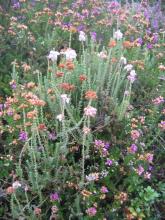The fall is upon us, at least in the mountains. Last weekend we had a fantastic weather and almost summer temperatures. Not much in flower in the mountains but the color of fall deepens.
1) Betula nana
2) Gymnocarpium dryopteris
3) Geranium sylvaticum leaf
4 & 5) Arctous alpina
6) View
Comments
Re: The color of fall
Wow! I love the mix of cool green lichen with red bearberry - fabulous scenes!
Re: The color of fall
The colors are not at their peak yet, that happens in a couple of weeks. But then I'll not be there!
By the way, bearberry translates to "bjørnebær" in Norwegian, but "bjørnebær" is the Norwegian name of blackberry (Rubus fruticosus coll)! Bearberry is called "rypebær" (ptarmigan berry) in Norwegian.
End of lesson.
Re: The color of fall
Ah, you'll have us all reading Norwegian before long, if not speaking it! ;)
Bearberry is called "rypebær" (ptarmigan berry) in Norwegian.
End of lesson.
So the Norwegian common name for Arctuous is "rypebær" (ptarmigan berry)?
Re: The color of fall
Ah, you'll have us all reading Norwegian before long, if not speaking it! ;)
Yes, you have got it! It is not that difficult.
Bearberry is called "rypebær" (ptarmigan berry) in Norwegian.
End of lesson.So the Norwegian common name for Arctuous is "rypebær" (ptarmigan berry)?
Correct. You can as well use Norwegian names for berries, not only Swedish lingonberry! (That is "tyttebær" in Norw.)
Re: The color of fall
Interesting that you call bearberry "partridgeberry'.....we use that common name for our lingonberry! Locally, we call bearberry "foxberry". Meanwhile, New Englanders use partridgeberry as the common name for Mitchella repens and they call lingonbery "rock cranberry"...it's all so confusing!
Re: The color of fall
Interesting that you call bearberry "partridgeberry'.....we use that common name for our lingonberry! Locally, we call bearberry "foxberry". Meanwhile, New Englanders use partridgeberry as the common name for Mitchella repens and they call lingonbery "rock cranberry"...it's all so confusing!
An example of why common names are not very meaningful nor universal, thus the reason there is exists a universal language of plant names, the latin binomial :)
Re: The color of fall
An example of why common names are not very meaningful nor universal, thus the reason there is exists a universal language of plant names, the latin binomial :)
And thanks for that!
You know Carl von Linné (Linnaeus) also had the idea that all plants in the World could be grown in Sweden if he just "learnt them" to tolerate the climate. Therefore he got his student to send him whatever they found, and especially food plants and plants grown for other reasons, when they travelled abroad. Linné dreamed of farming in Swedish Lapland to make Sweden independent of importing from other countries.
Re: The color of fall
I had thought to follow this thread up a bit earlier but haven't had time.
The new pictures are not alpine but contrary, almost as far away from the high altitudes you can get. But the treeless landscape - or better the former treeless landscape - looks very alpine in some regards. This landscape is part of an island called Karmøy at the west coast of Norway. (The king that united Norway more than 1100 years ago, lived here; and maybe the country got its name from the channel separating the island from the mainland. In old Norse (possibly): norðvegr (= north way).
This island is part of the heathland of the European west coat, a type of landscape you find from Portugal in the south to north in Norway. The heathland is originally cultivated land used as pastures for grazing animals. Here the herds could forage all winter as the heath stayed green. To maintain the young growth large patches were burnt on a regular basis. Today almost nobody keep this tradition alive with the result that the heath evolve to woodland. Many places this is accelerated by forest planting.
The commonest heathers here are Calluna vulgaris, Erica purpurea and Erica tetralix. These are the showiest too and gardenworthy. They color the hills in August and September.
In Norway the American spruce Picea sitchensis is planted all along the coast as it tolerates salty spray from the ocean. Different foreign pines such as Pinus mugo and P. uncinata are also much used.
#1 The wetter area has less heather and more segued and such plants. It is very acidic here.
#2 The drier land is covered by heather and juniper - and spruce.
#3 Fences to separate properties.
#4,5 Rocky but no rock gardens!
#6 When you approach the seaside the soil gets more nutritious with more grass. The ocean - North America next! You can spot a floating wind mill, a prototype (Hywind) to be built in huge numbers for use in open waters.
Re: The color of fall
#7 Landscape
#8 Calluna vulgaris, the common heather or ling. The Norwegian name is røsslyng meaning "horse ling".
#9 Erica tetralix
#10 Erica purpurea which is extremely oceanic.
#11 Lathyrus japonicus maritimus One of the showier plants at the beach still flowering.
#12 Carex arenaria. Together with the grasses Ammophila arenaria and Leymus arenarius it is very important to bind the sand.


Trond,
Beautiful autumnal colours ... thanks for posting.